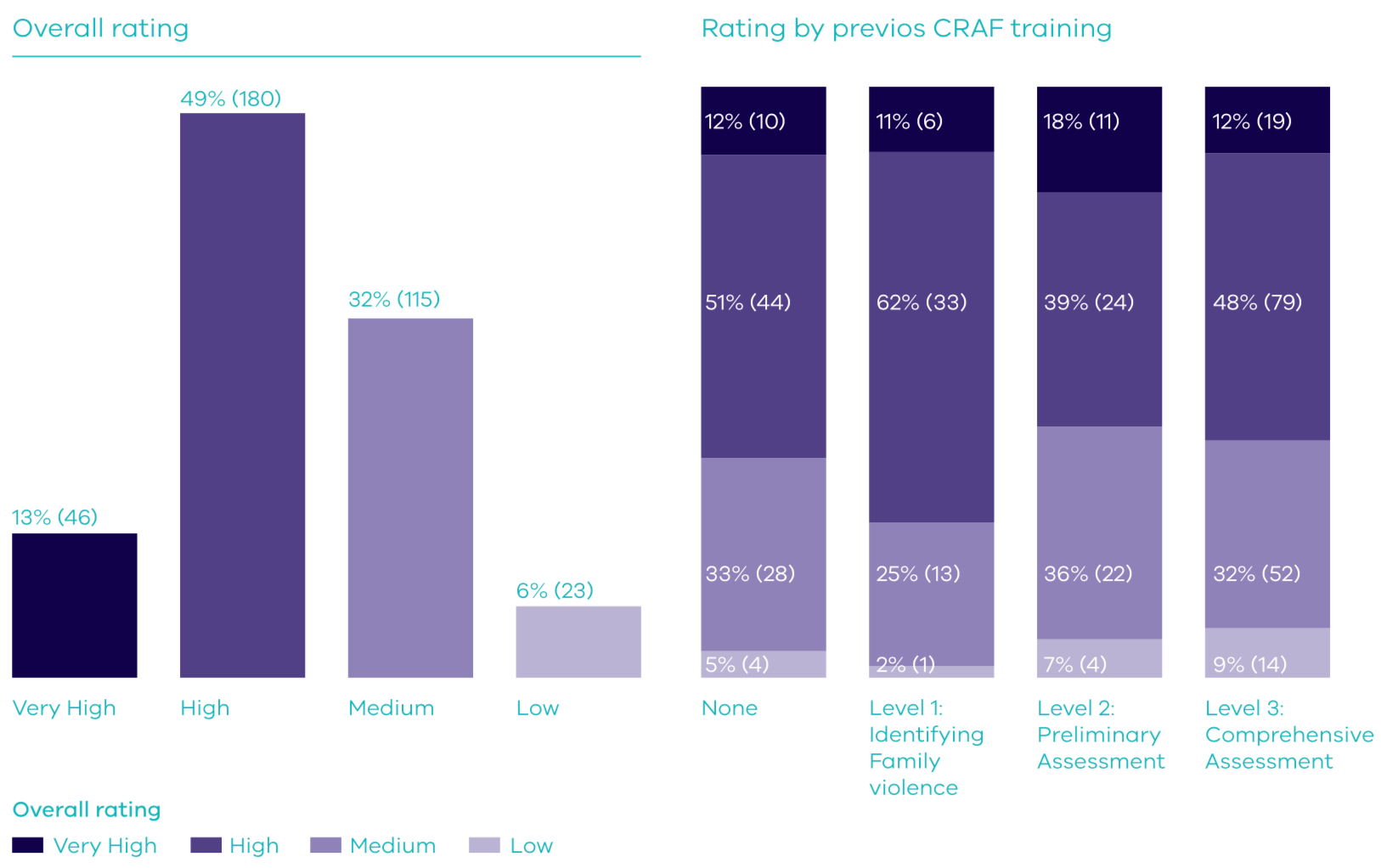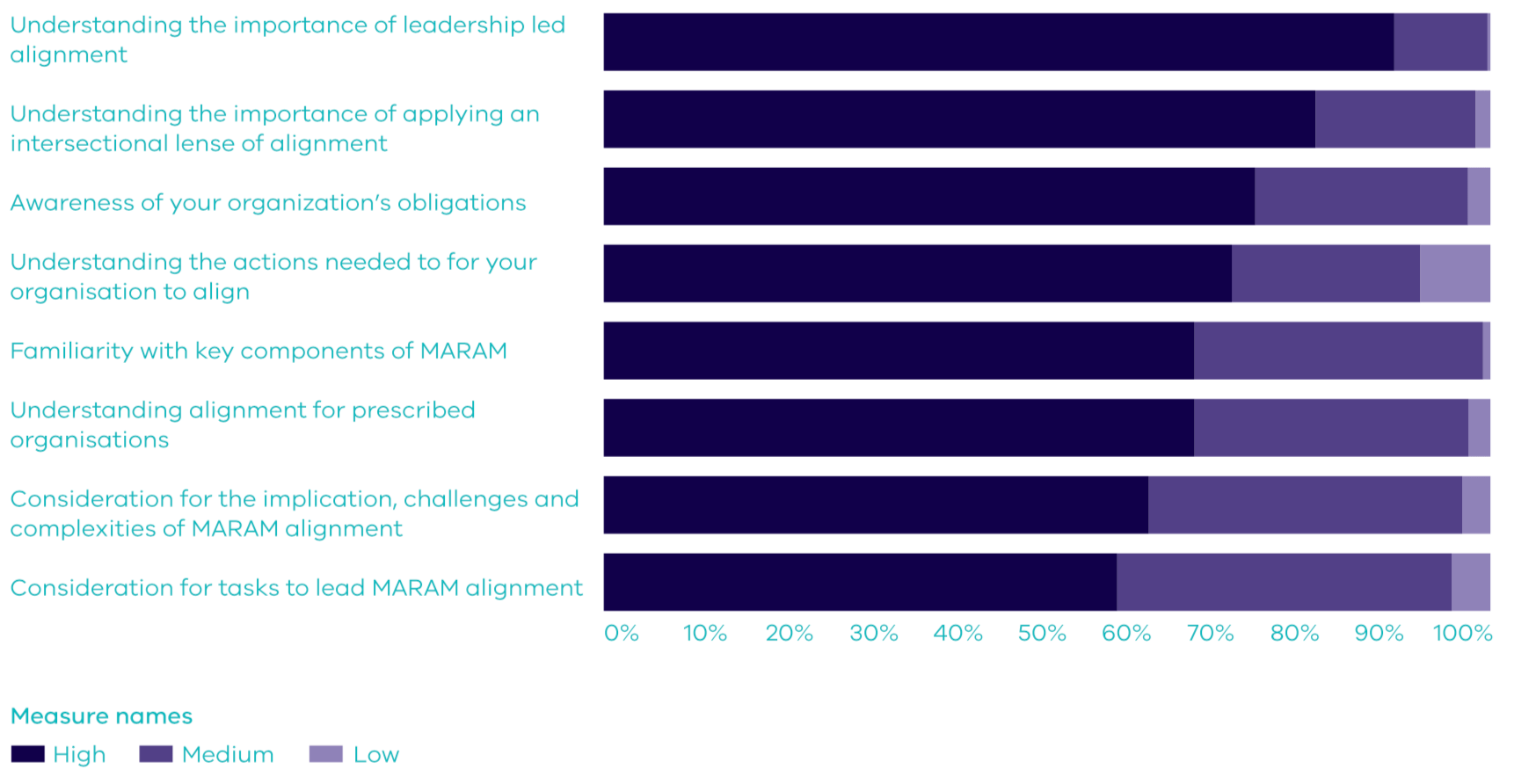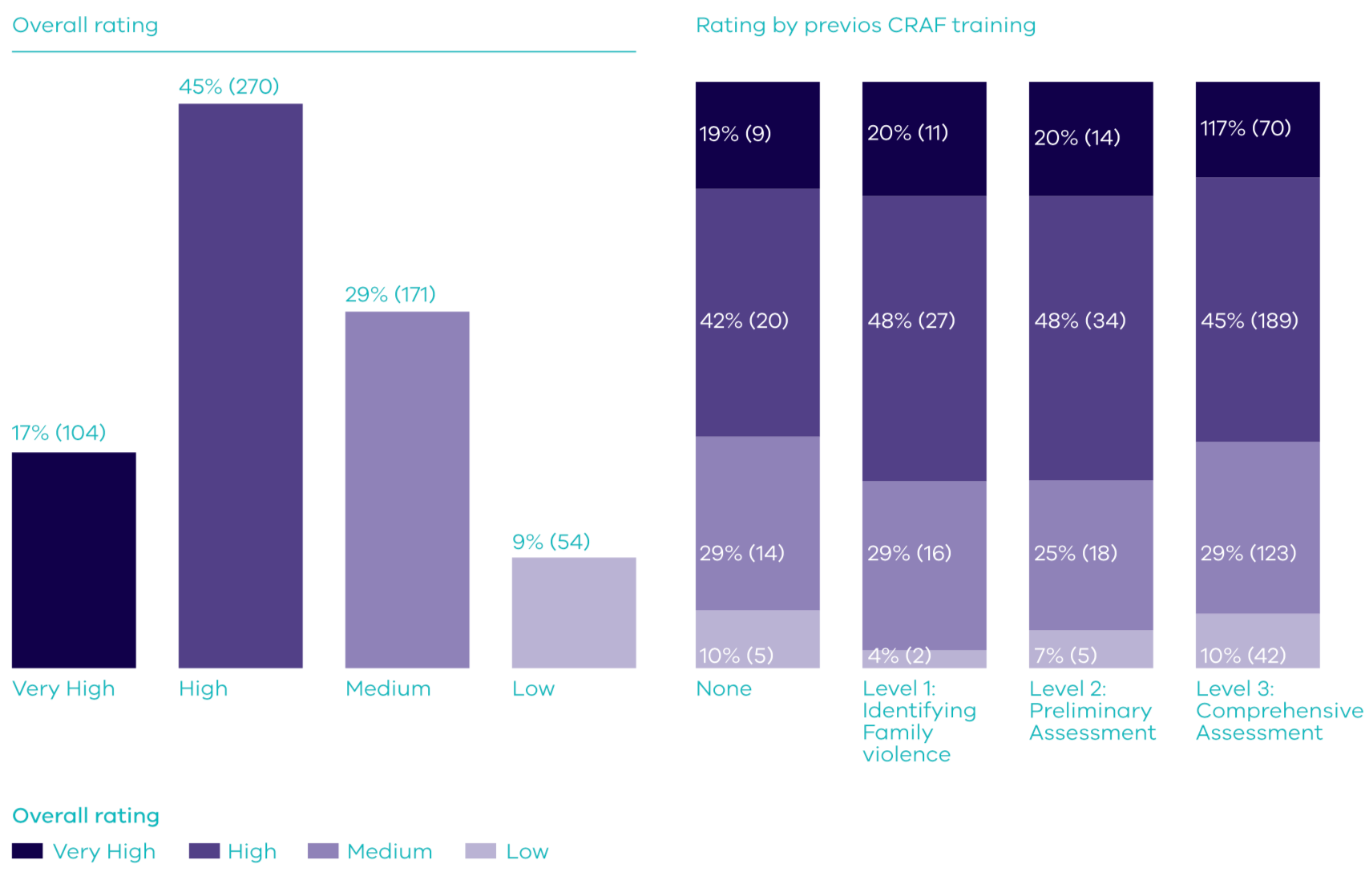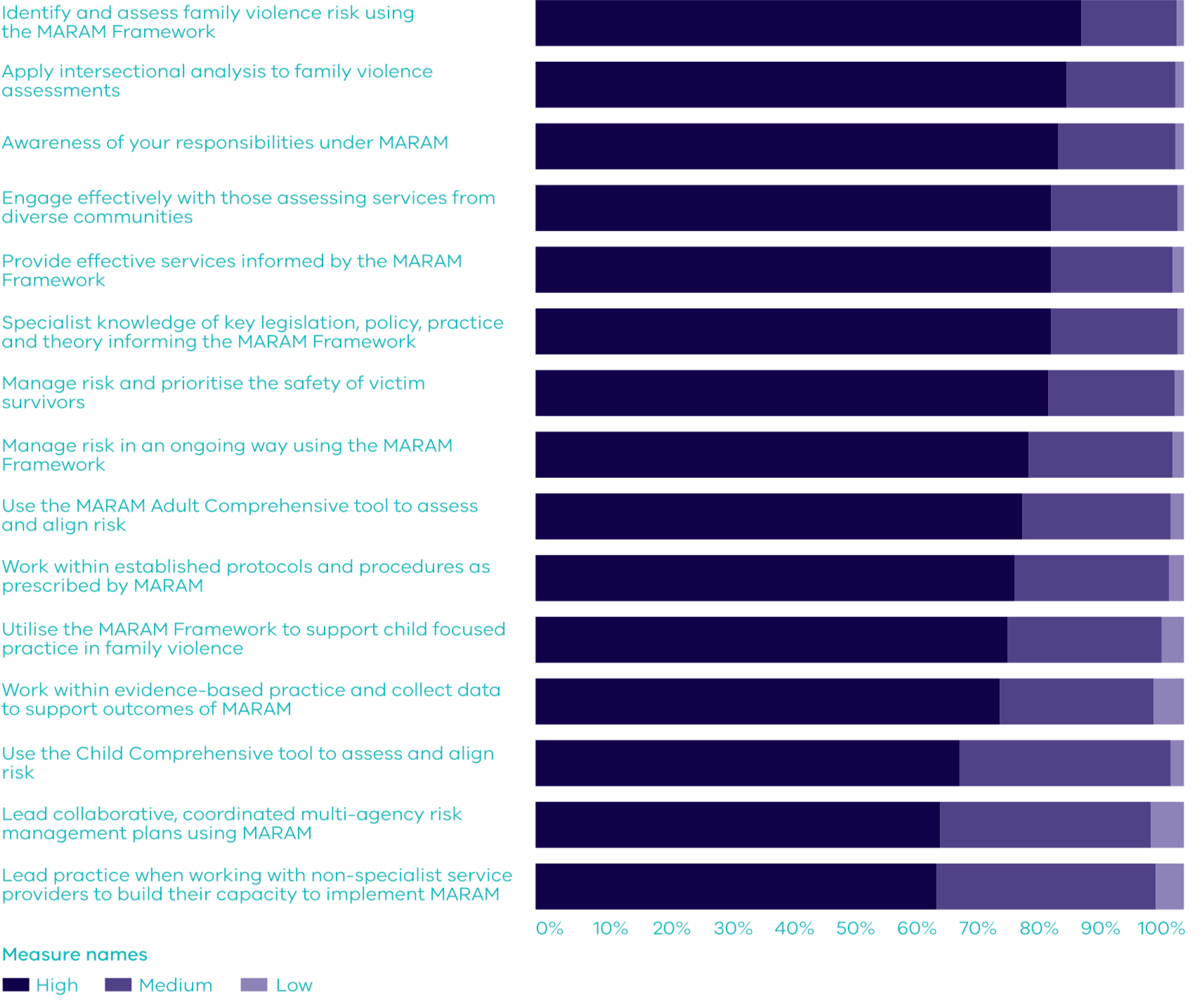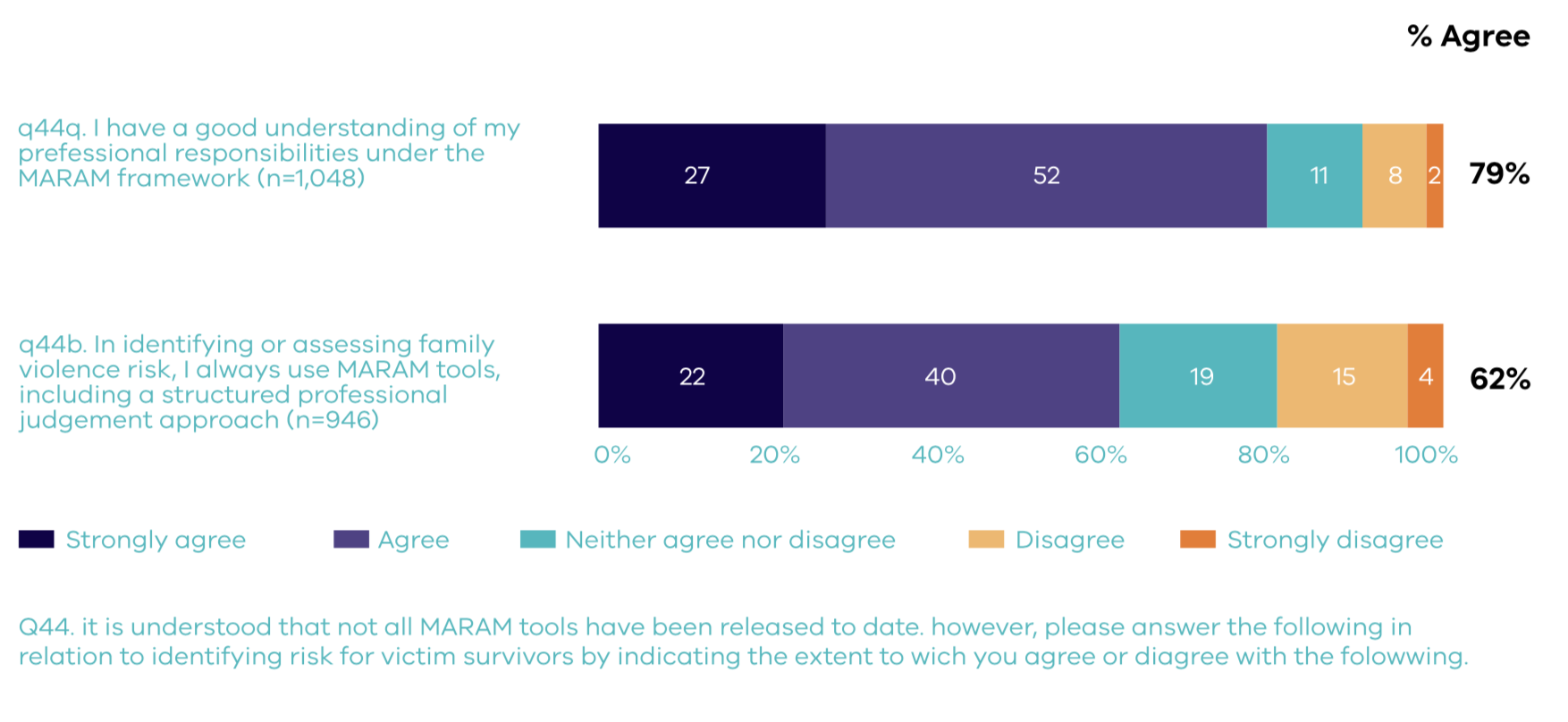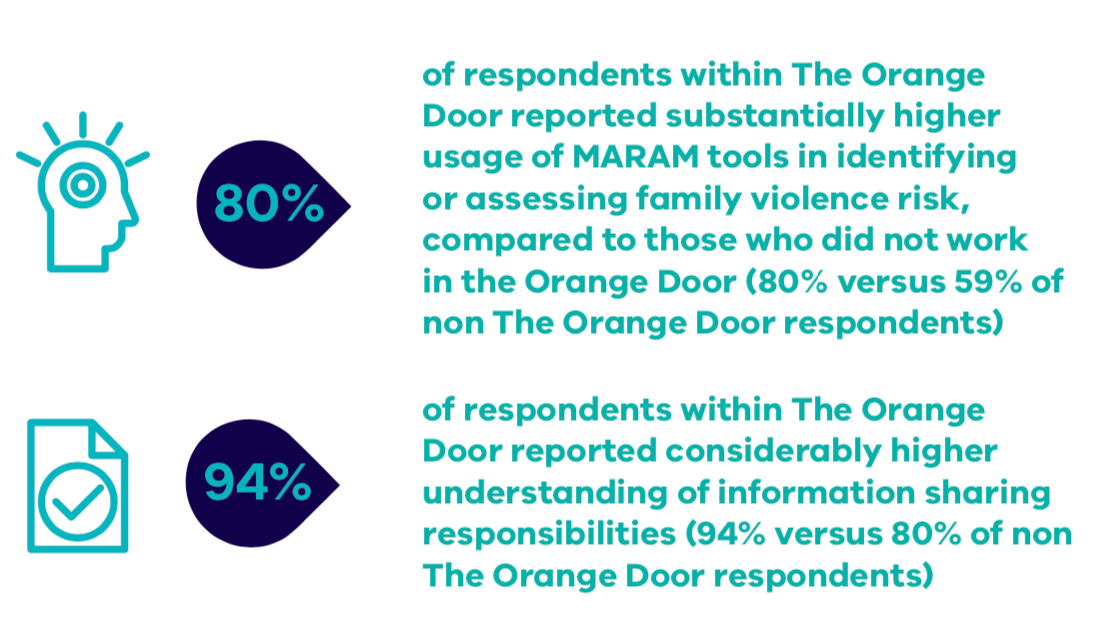3. Build workforce and staff capability
Successful implementation of the reforms requires practitioners to be appropriately trained in their MARAM and information sharing responsibilities. This is a significant task. Phase 1 prescribed approximately 37,500 professionals across 850 organisations. Phase 2 will likely prescribe up to 370,000 professionals in 5,850 organisations.
All face to face training delivery was disrupted in March 2020 owing to the outbreak of the COVID-19 pandemic and associated public health restrictions. Some services were able to pivot training to online prior to the end of the reporting period, but annual numbers trained are lower than previously anticipated as a result of these unforeseen circumstances.
Highlights
- 18,671 workers have been trained in MARAM, FVISS or CISS across all platforms (as at June 2020)
- Two-thirds of participants in the Leading Alignment post-training survey rated the overall module as high or very high
- In the Victims Services, Support and Reform portfolio 90 per cent of Victim Support Officers have received in-house MARAM and new L17 training and 75 per cent Foundational Family Violence Training by the Office of the Family Violence Principal Practitioner
FSV – Reform lead
FSV is pursuing a multipronged approach to the delivery of MARAM family violence training.
Non-accredited MARAM training
Non-accredited training has been centrally developed to cover all MARAM responsibilities through the following MARAM training modules:
- MARAM Screening and Identification for professionals of prescribed organisations who may identify family violence is occurring and who engage with people in a one-off episodic or ongoing service environment and are able to identify or screen for family violence
- MARAM Brief and Intermediate for professionals whose purpose of intervention is linked to family violence but not directly focused on family violence
- MARAM Comprehensive Family Violence Risk Assessment and Management (Comprehensive) for professionals specialising in family violence who are newer to the field and/or those who have not completed specialist Family Violence Common Risk Assessment and Risk Management Framework (CRAF[17]) (level 3) training
- MARAM Comprehensive Family Violence Risk Assessment and Management (Renewing Practice) for experienced professionals specialising in family violence who have previously completed specialist CRAF (level 3) training
- MARAM Leading Alignment for leaders and organisational managers to understand what is required under the MARAM Framework to demonstrate organisational alignment. It is multisector training and supports shared learnings across workforces with respect to alignment and implementation of MARAM.
- MARAM Collaborative Practice designed for workforces from all prescribed organisations who are not specialist family violence professionals. It is the successor for Identifying Family Violence training which was based on CRAF.
The non-accredited comprehensive modules and Leading Alignment continue to be provided by the Domestic Violence Resource Centre Victoria (DVRCV) to specialist family violence advisors. The non-accredited Screening and Identification and Brief and Intermediate modules have been provided to departments to be tailored for their workforces, and to complement their own training strategies. The MARAM collaborative practice module is being delivered by Regional Principal Strategic Advisors (PSAs) and is available to all workforces.
During the year 2019–20:
- 256 organisational leaders attended Leading Alignment[18]
- 1,705 specialist family violence workers attended comprehensive training[19]
- 1,416 attendees of MARAM collaborative practice.[20]
Attendees of the Leading Alignment and Comprehensive Training modules are asked to complete a survey before and after the training.
Leading Alignment
The post-Leading Alignment survey indicates that almost two-thirds of participants in Leading Alignment training rated the overall module as high or very high. These ratings were influenced by the amount of prior family violence knowledge, with higher ratings being correlated with participants who had completed no or Level 1 CRAF training.[21]
Participant ratings for Leading Alignment training overall and by the level of previously completed CRAF training (n=364)
This shows that a majority felt they had a high or very high understanding of all minimum learning objectives associated with Leading Alignment training, and thus a majority of Leading Alignment participants should be well equipped to support organisational alignment. However, the results indicated the training may have lacked enough guidance on the practical steps that organisations should take to align. This is demonstrated by the following ratings:
- While 71 per cent of respondents felt they highly understood the actions needed for their organisation to align, 21 per cent rated themselves as having a medium understanding and 8 per cent rated themselves as having a low or very low understanding after training.
- 42 per cent of participants rated their consideration for tasks to lead MARAM alignment as medium or low after training.
This has now been addressed through the development of organisational embedding resources and the organisational self-audit tool. Leading Alignment training delivered online from September 2020 will include activities and training linked to the OEG.
Ratings of knowledge across the minimum learning objectives after completing Leading Alignment training
Note the high category includes answers for ‘high’ and ‘very high’ and the low category includes answers for ‘very low’ and ‘low’.
Comprehensive Renewing Practice
The Renewing Practice post-training survey found that 62 per cent of respondents rated the training as ‘very high’ or ‘high’. Participants who had previously completed either Level 1 or 2 CRAF training rated it higher than those who had not completed any CRAF training or Level 3 training.[22]
Participant ratings for Renewing Practice training overall and by the level of previously completed CRAF training (n=599)
After training, respondents rated themselves highest on their:
- ability to identify and assess family violence risk using MARAM (84 per cent rating of ‘very high’ or ‘high’)
- to apply intersectional analysis to an assessment of family violence risk (82 per cent)
- awareness of their professional responsibilities under MARAM (81 per cent).
Post-training, participants felt they were least able to:
- lead collaborative, coordinated multiagency risk management plans, with more than one-third (37 per cent) rating their ability as medium or low
- lead practice when working with non-specialist service providers, with 38 per cent rating their ability as medium or low.
Ratings of knowledge/ability across the minimum learning objectives after completing Renewing Practice training
Note the high category includes answers for ‘high’ and ‘very high’ and the low category includes answers for ‘very low’ and ‘low’.
MARAM accredited training
As identified in the first MARAM annual report, it is essential for long-term success that MARAM is built into pre-service qualifications for professionals who work within prescribed organisations. FSV has continued to work with DET to develop new accredited family violence training which is MARAM aligned. The 2021 Skills First contract strongly encourages training providers to import the existing unit VU22733: ‘Identify and provide initial response to family violence risk’ as an elective in all community services training courses to build family violence literacy.
The first unit (22510VIC Course in Identifying and Responding to Family Violence Risk) was accredited by the Victorian Registration and Qualification Authority (VRQA) in April 2019. The course is consistent with non-accredited MARAM Screening and Identification training; it covers family violence foundational knowledge and is available to all workforces regardless of MARAM prescription. This approach provides an opportunity for family violence and MARAM to both be directed towards existing workforces and to be part of pre-service training for a wide range of workforces as the units can be imported into a range of other training courses. Exemptions to some of the eligibility criteria for a government-subsidised training place at a Skills First[23] contracted provider will provide training places with either low or no tuition fees to a broad range of people, including those with other existing qualifications.
Building on from the first unit (22510VIC Course in Identifying and Responding to Family Violence Risk), the Course in Intermediate Risk Assessment and Management of Family Violence Risk (22561VIC) was accredited by the Victorian Registration and Qualifications Authority in July 2020. This course:
- is consistent with MARAM brief and intermediate risk assessment and management
- contains two units – the first being the unit from 22510VIC and the second being a new unit focusing on MARAM responsibilities 3 and 4, including perpetrators and adolescents using family violence, requiring adherence with the yet to be released MARAM perpetrator practice guidance.
Course resources and assessments are in the process of being developed, with delivery of the second course scheduled to commence from early 2021. This means that the course will be available for any Phase 1 workforces not yet trained who wish to access the accredited course, and any Phase 2 workforces being prescribed in 2021. It will also be available to relevant workforces beyond those prescribed under MARAM. A number of training organisations are undertaking the necessary professional development to prepare for the delivery of this and other accredited training courses. A family violence professional development program is being delivered by the Vocational Education and Training (VET) Development Centre. Demand for training has been strong.
The scope for a course in Comprehensive Risk Assessment and Management of Family Violence will be developed in late 2020, which will then be tested with key family violence peak bodies, other experts and industry representatives. This course will be consistent with MARAM comprehensive risk assessment and management and participants are to be limited to learners who hold relevant qualifications to be a specialist family violence practitioner. It will also have a strong focus on Aboriginal cultural safety. Delivery is anticipated from mid-2021.
FSV is currently working with DET to deliver a communications plan to encourage uptake of accredited units (when available) and to support understanding of how non-accredited and accredited training complement each other.
To support the rollout of accredited training, DET is collaborating with FSV to plan the development of a best practice education model for family violence accredited training to underpin the future delivery from the TAFE setting. The best practice model will support family violence trainers to be appropriately skilled to deliver safe, high-impact, and expert-led accredited training across Victoria. This will apply to both current trainers and measures to be implemented to increase the numbers of trainers to grow the supply of training places. Development of the best practice model will commence in late 2020. In the interim, professional development for family violence trainers is and will continue to be available through the VET Development Centre.
DJCS
Portfolios within DJCS have continued a strong focus on training across the workforce. This includes training existing workforces in foundational family violence knowledge to increase a shared understanding and updating introductory training, tailored and specific training on MARAM responsibilities and use of tools such as information sharing and where appropriate more specialised training to promote continuous improvement (such as Victim Services, Support and Reform engage in predominant aggressor training).[24]
Highlights include:
- 90 per cent of current Victim Support Officers from Victims of Crime Helpline have undertaken inhouse MARAM and new L17 training
- 75 per cent of current Victim Support Officers from Victims of Crime Helpline have undertaken external MARAM training including leading alignment
The Courts
The courts have partnered with the DVRCV to deliver training to the comprehensive workforce and online delivery has commenced. Alongside comprehensive MARAM training, the courts are facilitating a FVISS “professional development blitz” by promoting Whole of Government eLearning modules to be accompanied by in-house webinars to contextualize the FVISS to the court’s operating environment.
The courts are developing further MARAM training materials and are planning to embed MARAM training into existing court processes.
This will include training modules for
- operational leaders, to help them effectively support frontline staff to apply the MARAM Framework
- human resources, to help them support staff who are experiencing family violence.
The courts will embed MARAM training into the Trainee Court Registrar program and orientation for all new starters and training for Court Network volunteers and will engage with the Judicial College of Victoria to implement training for the judiciary.
Court Network has aligned existing volunteer training with the MARAM Framework. One hundred and fifty volunteers have completed this revised training.
Case study: the courts, SFVS, legal services
A registrar from the Magistrates’ Court of Victoria referred a woman from a culturally and linguistically diverse background who presented as anxious to a Court Network volunteer. The woman was at court for a police-initiated family violence matter. The volunteer was able to facilitate access to a quiet room to talk to the woman about her immediate concerns and complete a screening MARAM assessment via an interpreter. The assessment indicated that family violence was occurring, and that an immediate response was required. The volunteer facilitated a warm referral to a legal service and specialist family violence service that supported the woman to access a high security refuge.
Koori Justice Unit (KJU)
All relevant Koori Women’s Place[25] staff members have attended available MARAM and FVISS training, as have the majority of Ngarra Jarranounith Place[26] staff members. Djirra and Dardi Munwurro are external service providers that provide ongoing activities to lift staff knowledge and capability in relation to the identification, assessment and management of family violence risk through MARAM, and how to share risk-relevant information to keep victim survivors safe and people who use family violence in view.
KJU will continue to promote cultural safety to mainstream organisations working with Aboriginal and Torres Strait Islander people to enhance working relationships, improve information sharing and provisions for secondary consultations.
Victoria Police
Training for Victoria Police is managed through the People Development Command. To ensure consistency in the application of the Family Violence Response Model mandatory force-wide training is required in family violence – as at June 2020, 83 per cent of Victoria Police’s operational workforce (up to the rank of superintendent) have completed the training. Additionally, the Centre of Learning for Family Violence has developed a FVISS and CISS training package for all Victoria Police employees.
Relevant Victoria Police staff attended MARAM Leading Alignment training and MARAM Framework training to ensure alignment to the framework when operationalising it through deployment of the Family Violence Response Model, which includes the FVR.
MARAM training has been continually delivered to new recruits throughout the COVID-19 pandemic.
DHHS
Information sharing and introduction to MARAM training
In 2019, DHHS developed and delivered statewide face-to-face cross-sector training on the CIS and FVISS, which was available to all Phase 1 DHHS and DHHS-funded workforces. This training aimed to:
- develop an understanding of the CISS and FVISS (Pillars 1 and 2)
- foster a shared understanding of family violence (Pillar 1)
- promote consistent and collaborative practice (Pillar 2)
- provide an introduction to MARAM.
The face-to-face information sharing training was attended by DHHS and DHHS-funded workforces, including Child Protection practitioners, AOD workers, and Homelessness practitioners.
In late 2019, this face-to-face training was converted to a tailored eLearn for the MCH workforce, which uses sector-specific examples to bring practice implications for MCH practitioners to the fore.
MARAM training
DHHS tailored the Screening and Identification and Brief and Intermediate training for delivery to its Phase 1 workforces. Some face to face training was delivered in February and March 2020 before the impact of the COVID-19 pandemic. The training was urgently converted to online interactive webinars and delivered from May 2020.
Using Sector Grant funding and additional funding from DHHS, VACCA and the CECFW delivered MARAM Screening and Identification and Brief and Intermediate interactive webinar training to VACCA staff in July and August 2020.
DHHS is developing tailored MARAM eLearn packages for practitioners who align to Screening and Identification and Brief and Intermediate. The eLearn modules will be made available to existing Phase 1 workforces and to prepare Phase 2 workforces.
The eLearn packages will include foundational modules on MARAM and information sharing and will enable practitioners to build on their learning through tailored content, interactive learning and case studies.
Housing
The new Housing operating model will align with MARAM and include relevant MARAM responsibilities. As the changes to the Housing workforce are anticipated to commence in late 2020, the roll-out of MARAM Screening and Identification training, specific for the Housing workforce VPS 4–6, is expected to commence in early 2021 in preparation for commencement of the new Housing operating model.
Child Protection
MARAM training specifically for the Child Protection sector was developed and due to be delivered throughout April to June 2020, but could not proceed due to COVID-19. The modules are being converted into a three-stage online training program for the 2020-21 financial year.
- Stage 1 is an introduction to the MARAM Framework, responsibilities, and the tools which practitioners are required to use in Child Protection. After completion of Stage 1, practitioners receive a weekly MARAM newsletter prompting ongoing self-reflection, supervision tasks, case studies, practice skills and key messages from partners, management and leadership.
- Stage 2 takes the practitioner into a deeper understanding of effective engagement, evidence-based risk factors, trauma and use of the Family Violence Screening and Risk Assessment.
- Stage 3 builds on the practitioner’s understanding of risk management by working collaboratively with the victim survivor, holding the perpetrator accountable and engaging effectively with the service sector to achieve best outcomes.
As well as more traditional training, Child Protection workforces have additional learning methods to help build capability. MARAM is an ongoing professional development tool distributed to Child Protection on a weekly basis after they complete their MARAM in Child Protection Stage 1 training. The MARAM builds on the foundational knowledge delivered in Stage 1 training and continues the practitioner’s journey of alignment with MARAM practice.
Between 17 April 2020 and 30 June 2020, DHHS delivered a 20-minute weekly Discussion Series online live sessions to the Child Protection workforce. These sessions will continue to be delivered during 2020-21 on a fortnightly basis for half an hour. All Child Protection practitioners in the state are invited to attend. On 1 May 2020, the Discussion Series focused on Family Violence Practice during COVID-19. Throughout July, August and September 2020, topics will be focused on family violence including the impact of family violence on the child, perpetrator accountability and information sharing. An average of 250 practitioners attend each live session.
Census of workforces that intersect with family violence
The Royal Commission into Family Violence highlighted the lack of detailed knowledge and essential workforce data about family violence in Victoria. Under the Industry Plan, a workforce Census will be conducted every two years, which will inform workforce planning and improvements for workforces that intersect with family violence.
The Census collects data across a wide range of workforces including:
- specialist family violence
- primary prevention
- services across the community services, health, justice, and education and training sector.
The Censuses led by FSV in partnership with peak bodies and member agencies in the family violence sector. The first Census was conducted in 2017 prior to the release of the MARAM Framework, and the second Census was conducted in late 2019 and early 2020.
The overarching aim of the 2019-20 Census was to assist in deepening understanding of a range of workforce issues, and to continue to build the evidence base to inform ongoing workforce capability development in responding to family violence, and broader Industry Planning.
The Census found that workers from a range of organisations prescribed to align with MARAM:
Of those who worked for organisations prescribed to align with the MARAM framework (representing a broad range of workforces), understanding of one’s professional responsibilities under the framework was widespread (79 per cent). Additionally, a majority (62 per cent) consistently used MARAM tools (including a structured professional judgement approach) in identifying or assessing family violence risk.
Key results across all organisation types on confidence, understanding of MARAM responsibilities, use of MARAM tools and understanding of information sharing responsibilities are shown below. It will be noted there is a variance in confidence levels and understanding, as well as use of tools. Some services are in Phase 1 of prescription and some in Phase 2 (that is, hospitals, community health, education sector) and progress can most appropriately be assessed with future reports as the reforms continue to roll out and MARAM maturity increases.
Key results by organisation type[29]
|
Organisation type |
Confidence in level of training and experience (% confident at Q37) |
Understandingof responsibilities under MARAM (% agree at Q44a) |
Usage of MARAM tools (% agree at Q44b) |
Understanding of information sharing responsibilities (% good at Q46) |
|
Overall workforce (n = 946–1,486)* |
61% |
79% |
62% |
81% |
|
Specialist family violence victim survivor services (n = 448–570) |
72% |
82% |
64% |
87% |
|
Specialist family violence perpetrator services / men's behaviour change (n = 142–190) |
59% |
86% |
65% |
86% |
|
Aboriginal community-controlled organisation (n = 27–36) |
58% |
96% |
74% |
85% |
|
Alcohol or other drug services (n = 33–40) |
45% |
76% |
58% |
85% |
|
Victims assistance (n = 26–38) |
53% |
67% |
58% |
71% |
|
Peak body (n = 13–46) |
57% |
87% |
62% |
65% |
|
Women’s health (n = 13–-36) |
61% |
78% |
54% |
66% |
|
Child protection (n = 9–14) |
79% |
91% |
^ |
93% |
|
Community health (n = 70–108) |
50% |
80% |
64% |
79% |
|
Courts and court services (n = 50–84) |
57% |
63% |
32% |
80% |
|
Family safety contact (n = 31–37) |
70% |
84% |
65% |
88% |
|
Hospital (n = 24–70) |
59% |
57% |
38% |
66% |
|
Housing / social housing / homelessness (n = 38–53) |
58% |
79% |
50% |
73% |
|
Legal services (n = 16–110) |
55% |
75% |
50% |
65% |
|
LGBTIQ services (n = 13–23) |
61% |
86% |
85% |
86% |
|
Mental Health services (n = 27–42) |
52% |
67% |
48% |
70% |
|
Multicultural or settlement services (n = 10–16) |
31% |
80% |
70% |
64% |
|
Older people (including elder abuse) services (n =5–15) |
60% |
^ |
^ |
75% |
|
Education and training provider (family violence) (n = 16–38) |
71% |
78% |
69% |
75% |
|
Sexual assault services (n = 55–72) |
57% |
81% |
55% |
80% |
|
Regional integration (n = 8–13) |
77% |
82% |
^ |
90% |
*n = indicates the range of the sample sizes across the four key questions.
^Result suppressed due to low sample size (n < 10).
Source: 2019–20 Census of workforces that intersect with family violence
Of note, those who worked in The Orange Door reported a greater use of MARAM tools and information sharing which would be expected with the links to CIP reports and the early adoption of TRAM.
The Census was undertaken between November 2019 and February 2020, after the prescription of Phase 1 organisations. It is positive to note that there is already a strong understanding of MARAM responsibilities and information sharing, most notably among Phase 1 organisations but also in Phase 2 organisations that are not yet prescribed. Services that adopted the MARAM tools at an early stage, such as The Orange Door, are reporting a substantially higher use of MARAM tools and this is a trend it is hoped will continue as more and more services adopt and embed MARAM tools.
The Census will be undertaken every two years and in the annual report to be tabled in 2023 will be able to provide data around the impact of MARAM alignment and progress made upon workforces responding to family violence.
Assessment of MARAM progress
It will take time to raise the capability of an estimated 370,000 workers and to increase confidence levels and reduce barriers. The MARAM evaluation recommended that all departments undertake a training needs analysis as anticipated by the Whole of Government change management strategy where not already undertaken to help inform prioritisation of future training.[30] The effectiveness of online modules being developed and delivered due to COVID-19 will also need to be reviewed and evaluated as training options progress, particularly for Phase 2 workforces where attendance at full training days may be more difficult. Online training provides an opportunity to reach workforces on a wider basis.
All departments are conscious of the need to provide training and many planned training delivery sessions were put on hold due to COVID-19. However, this has produced an opportunity to pivot training to an online mode of delivery which may increase accessibility whilst many are working from home and services reduced, as well as assist Phase 2 workforces and it is hoped that future annual reports will demonstrate a marked increase in available training.
‘Prior to the current COVID-19 pandemic, workforces were having issues attending MARAM training as the demand was higher than the training could accommodate. The recent innovation of MARAM training moving online presents an opportunity for accessibility issues to be address’ (peak body).
The development of accredited training and embedding into pre-service qualifications also enables an opportunity for Phase 2 workforces to utilise a greater array of training options, with FSV brokering between TAFEs and organisations to ensure accredited training is tailored and delivered conveniently where demand requires it.
Whole of Government training products have been developed and delivered as the reforms have progressed. To continue to develop skills and practice knowledge for staff, future training solutions that are tailored to workforces are required. Learning systems need to be implemented across workforces that allow current and future staff to continue to develop their practice, relevant to the functions of their role.
This may include resources and strategies such as: online modules, scenario-based modules and induction materials that encourage alignment to MARAM and enable the appropriate and timely sharing of information. Furthermore, departments and sector peaks should also identify other opportunities to develop staff capabilities that may complement training, such as the Child Protection Practice Discussion series discussed above.
The Census was undertaken in 2019 between November 2019 and February 2020 months after the prescription of Phase 1 organisations.
It is positive to note that there is already a strong understanding of MARAM responsibilities and information sharing, most notably amongst Phase 1 organisations but also in Phase 2 organisations that are not yet prescribed. Services that adopted the MARAM tools at an early stage, such as The Orange Door, are reporting a substantially higher use of MARAM tools and this is a trend it is hoped will continue as more and more services adopt and embed MARAM tools.
[17] MARAM was previously known as the common risk assessment framework (CRAF).
[18] Between July 2019 to March 2020.
[19] Between September 2019 to March 2020.
[20] Between October 2019 to March 2020 and June 2020.
[21] Of respondents who answered this question, 86 had not previously completed CRAF training, 53 had completed Level 1 CRAF, 61 Level 2 CRAF and 164 Level 3 CRAF.
[22] Of respondents who answered this question, 48 had not previously completed CRAF training, 56 had completed Level 1 CRAF, 71 Level 2 CRAF and 424 Level 3 CRAF.
[23] Skills First is a set of reforms for the training and TAFE sector. The reforms ensure that Victoria's training and TAFE system delivers high-quality training that leads learners to real jobs.
[24] Noting face to face training ceased owing to the coronavirus (COVID-19) pandemic with training pivoting to online modules.
[25] The Koori Women’s Place is a program of Djirra and is an extension of Djirra’s work and commitment to supporting Aboriginal women’s safety and wellbeing
[26] Ngarra Jarranounith Place builds on the vision and vast experience of Dardi Munwurro – Strong Spirit, to provide programs that build stronger families and safer communities. Ngarra Jarranounith Place translates to Men’s Healing Place in Woi Wurung language. The program is designed to support men who use or are at risk of using family violence to make positive changes in their lives.
[27] Q42: Before today, had you heard of the Multi-Agency Risk Assessment and Management (MARAM) framework? (n = 1,482)
[28] Q43: Is the organisation that you work for in your current role prescribed to align with the Multi-Agency Risk Assessment and Management (MARAM) framework? (n = 1,356)
[29] It should be noted that some of the organisations listed are Phase 2 and not yet prescribed for MARAM which would impact anticipated knowledge of the reforms.
[30] Cube Group 2020, Process evaluation of the MARAM reforms, final report, 26 June, p. 127.
Updated
